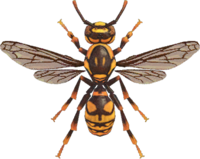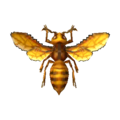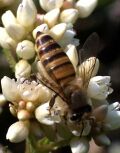Difference between revisions of "Wasp"
SuperHamster (talk | contribs) m (Text replacement - "\| image = (.*) NH Icon\.png" to "| image = $1 NH Icon.png | render = $1 NH.png") |
PanchamBro (talk | contribs) m (Text replacement - "{{Bugs}}" to "{{Navbox Bugs}}") |
||
| Line 261: | Line 261: | ||
{{Note list}} | {{Note list}} | ||
| − | {{Bugs}} | + | {{Navbox Bugs}} |
[[Category:Harmful bugs]] | [[Category:Harmful bugs]] | ||
[[Category:Doubutsu no Mori bugs]] | [[Category:Doubutsu no Mori bugs]] | ||
Revision as of 16:04, December 18, 2022
| ||||||||
 | ||||||||
| Real-world info | ||||||||
|---|---|---|---|---|---|---|---|---|
| Name: Unknown Family: Unknown | ||||||||
| Main appearances | ||||||||
|
| ||||||||
| Other appearances | ||||||||
Names in other languages
ハチ
벌 Vespa Wespe
黄蜂
Guêpe Avispa Wesp
黃蜂 Guêpe Avispa Оса | ||||||||
The Wasp (known as the Bee prior to New Horizons)[nb 1] is a bug in the Animal Crossing series that has appeared in every game to date. It is one of the many harmful bugs in the series, alongside the Tarantula and the Scorpion. If multiplayer is active or the player's gates are open, harmful bugs, including Wasps, will not appear.
In the games that the Wasp appears in, it is only found when a Wasp Nest drops when shaking a tree on some occasions. When this occurs, Wasps will chase after the player and sting them if not caught in time. A player cannot attempt to sit on a chair or lay on a bed while being chased by Wasps. The player can use a Party Popper to scatter the Wasps away. Wasps will temporarily stop chasing the player and circle around if the player is talking to a villager or special character, looking at their pockets or phone, looking at their emotes, or being underneath an arch. If a Wasp Nest falls from a tree and the player goes to talk to a villager, the villager will notice the wasps in the air and say something in fear such as, "Get away from me!"
If stung, the player's left eye swells. In Animal Crossing: New Horizons, if the player is stung by another wasp while still swollen, they will pass out and be returned to the front of their house. If they are on a Mystery Island or on Kapp'n's boat tour islands and they are stung twice, they will return to the front of the island. The player can be healed either with medicine, given by other villagers, brought for ![]() 400 Bells (
400 Bells (![]() 1,200 Bells in Doubutsu no Mori e+), or by crafting (only in New Horizons). The player could also save and end their game to remove the swelled eye, though this is not possible in New Horizons. Villagers will remark on the stung player's appearance, with normal villagers reacting in fright or concern and snooty villagers chiding the player for that attack (adding insult to injury); while cranky villagers can outright laugh at the player. In New Horizons, if the player wears a certain type of glasses while stung, villagers will not comment on the sting.
1,200 Bells in Doubutsu no Mori e+), or by crafting (only in New Horizons). The player could also save and end their game to remove the swelled eye, though this is not possible in New Horizons. Villagers will remark on the stung player's appearance, with normal villagers reacting in fright or concern and snooty villagers chiding the player for that attack (adding insult to injury); while cranky villagers can outright laugh at the player. In New Horizons, if the player wears a certain type of glasses while stung, villagers will not comment on the sting.
In Animal Crossing: New Horizons, it can be caught all year.
Catch details
In Animal Crossing
- "OWWWW! I got stung by a bee..."
- — The player after being stung by Bees, Animal Crossing
In Wild World
- "I got stung by BEES! Ow! Ow ow ow ow!"
- — The player after being stung by Bees, Animal Crossing: Wild World
| Description | These dangerous bugs are yellow and black. |
|---|---|
| Time of year | All year |
| Time of day | All day |
| Peak times | |
| Location | In trees |
| Bug size | 38 mm |
| Selling price | |
| Furniture size |
In City Folk
- "I got stung by a bee! Ow! Ow ow ow!"
- — The player after being stung by Bees, Animal Crossing: City Folk
| Description | These poison-carrying bees will attack big foes to protect the queen. |
|---|---|
| Time of year | All year |
| Time of day | All day |
| Peak times | N/A |
| Location | Shaking trees |
| Bug size | 38 mm |
| Rarity | Rare |
| Selling price | |
| Furniture size |
In New Leaf
- "Ow! Ow ow ow... I got stung by bees!"
- — The player after being stung by Bees, Animal Crossing: New Leaf
| Time of year | All year |
|---|---|
| Time of day | All day |
| Peak times | N/A |
| Location | Shaking trees |
| Size | 30 mm |
| Rarity | Rare |
| Selling price | |
| Furniture size |
In New Horizons
- "Ow! Ow ow ow... I got stung by wasps!"
- — The player after being stung by Wasps, Animal Crossing: New Horizons
| Time of year | North: All year South: All year |
|---|---|
| Time of day | All day |
| Location | Shaking trees |
| Weather | Any weather |
| Spawn requirement | Appears from the start of the game |
| Selling prices | |
| Furniture size |
Donating to the museum
In Animal Crossing
In Wild World
...I've recently heard that they also possess terribly replusive breath!
Of course, the gent who told me this was a bit of a rabit liar, but still! I would heartly endorse the following action if you see another: FLEE LIKE MAD! Stingers and bad breath, honestly! What monstrous little beasties..."In City Folk
The Bee can be found flying from tree to tree along the back wall of the museum's insect exhibit.
In New Leaf
Upon being donated, the Bee can be found in the room of the bug exhibit with the light in, flying around and resting on a tree in the back. The exhibit has this to say about the Bee:
In New Horizons
Upon donating the wasp to the museum the curator, Blathers, will say the following:
Gallery
Real-world information
Prior to New Horizons
Apis cerana japonica, the Asiatic honey bee, is a hardy species of bee that originates from South-Eastern Asia. It is used commercially for its honey, despite having a smaller yield than its European counterpart, Apis mellifera. Mellifera has, however, been subject to selective breeding for many centuries, greatly increasing honey output over the years.
It is unknown whether the Wasp in the Animal Crossing series is meant to be based on the Asiatic honey bee or Vespa mandarinia, the Japanese giant hornet, as the bee's Japanese name, hachi, can refer to both bees and wasps interchangeably. The Bee's in-game design in Animal Crossing: City Folk and Animal Crossing: New Leaf is more similar to the Japanese giant hornet, and the beehives seen in-game bear closer resemblance to a hornet's nest than to a real-world honeycomb, while in Animal Crossing: New Horizons, the insect's design is closer to a European paper wasp, a species more widely recognized as a wasp rather than a bee outside of Japan.
In New Horizons
Polistes dominula, the European paper wasp, is a species of wasp that originates from Europe, North Africa, and southeast and eastern Asia. Like the Asiatic honey bee, the European paper wasp is a social species, congregating in large hives composed of numerous interlinked hexagonal cells similar to a honeycomb; rather than being made from natural wax, however, these hives are constructed of paper, created by chewing wood into pulp and spitting it out, hence the name "paper wasp." A special protein in the wasps' saliva toughens and waterproofs the pulp, allowing the hives to maintain shapes like that seen in the Animal Crossing series and ensuring greater protection from predators. Paper wasps are known to be more docile than other wasps, such as yellowjackets and hornets, and do not sting unless provoked or their nest is under threat.
Names in other languages
| ハチ hachi |
Hymenopteran (can refer to bees, wasps, sawflies, etc.) | |
| 벌 beol |
Wasp | |
| 黄蜂 huángfēng |
Wasp | |
| 黃蜂 Unknown |
||
| Оса Osa |
Wasp | |
| Wesp | Wasp | |
| Wespe | Wasp | |
| Avispa | Wasp | |
| Guêpe | Wasp | |
| Vespa | Wasp | |
See also
Notes
| Bugs | ||||||||||||||||||||||||||
|---|---|---|---|---|---|---|---|---|---|---|---|---|---|---|---|---|---|---|---|---|---|---|---|---|---|---|
| ||||||||||||||||||||||||||









